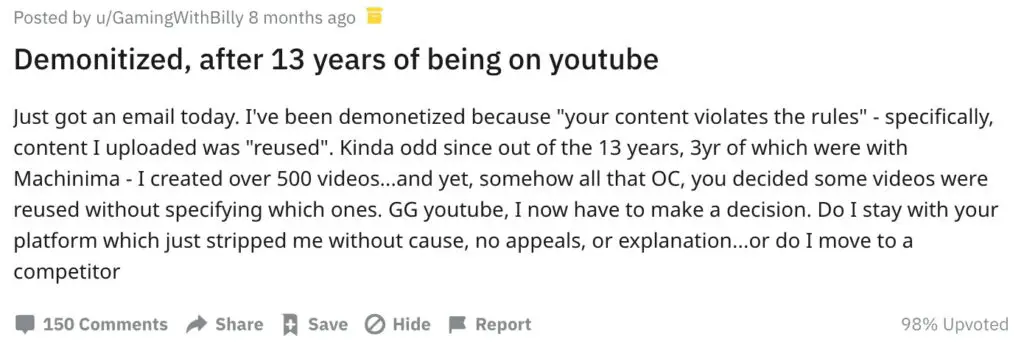
How To Host Videos On Your Website & Have Google Rank Them

Get helpful updates in your inbox
Publishers who produce video content are probably most familiar with using a third-party video hosting platform like YouTube, Vimeo, or Wistia. These platforms offer ease of use and the ability to embed videos in their written content. But there’s a downside to using these platforms—you give up a certain degree of control over your video content. So today I’m going to show you host to host videos on your website and have Google rank them.
How do you host videos on your website?
The first step to host videos on your website is to have full access to your website and know how your website works. What this means is you need the ability to get into the backend of your website, and also knowing specifications of your Content Management System, if you use one.
If you use WordPress, you can upload videos directly to your media gallery. But be aware, there is typically a maximum file size. Most videos that are 1080p, even ones that are just a few minutes in length, will go over the upload limit.

Tip: Sometimes you can get this upload limit removed just by simply emailing your hosting provider and asking them to remove it. But if you plan on self-hosting lots of video on your own site, you might want to consider upgrading your hosting plan to support larger file uploads. There’s also a few tutorials online showing how to increase the upload limit manually by adding code to the PHP file within your theme.
Once you have your video uploaded, you can let your video play on WordPress’s native video player, or there are a number of plugins and third-party players that support self-hosted videos.
The other way to host videos on your own website is to directly upload them to your web host through an FTP server like Filezilla.

For example: Using our host, WPEngine, we can take the SFTP Address and port number to directly upload files to our web host. When you put these files in a folder and put it on the web, it gets a URL. Then once you have the URL, any of these open-source video hosting options will work to display your video.
The FTP method is more complicated and not recommended for beginner publishers. The methods listed below are much easier.
What video hosting options are the easiest to use?
Cloudflare Stream is the undeniable winner for both its ease of use and affordability.

It’s an all-in-one video hosting service where publishers can upload and store their video content. It also offers features like adaptive bitrate technology, multiple playback options, signed URLs, closed captioning support, and more. Once your video is uploaded, an HTML5 player can be embedded into pages and posts on your site.
MediaElement.Js is another great option. It’s an open source HTML5 player. You self-host the video and then take the URL of the video to place in the code of the MediaElement player. It supports installation instructions for WordPress, Drupal, custom PHP, API functionality, and works across all browsers. There are also additional plugins you can add to your players like Chromecast and Google Analytics.
Cloudflare Stream and MediaElement.js are the cheapest and most versatile by a long shot. There’s also a number of web hosts that have partnered with Cloudflare, like WPengine.

WPengine uses them as their CDN. They have a plugin they built just so it makes the Cloudflare video streaming fit seamlessly with WordPress.
Why host video on your website vs. a platform like YouTube?
The biggest two reasons to host videos on your website versus a platform like YouTube is that you maintain control over your content and monetization.
On your website, you have full control over your content and your audience. You also have control over how you want to monetize your video.
In contrast, on YouTube, you have one choice. AdSense or not AdSense. You can directly sell ads, but then those ads are easily skippable.
On top of that, YouTube can say at any time (especially when policies continuously shift) that your content violates Google policy, say someone hit you with a copyright claim, etc. The list goes on and on. Take this example below from a YouTuber who was de-monetized after 13 years.

This thread is over 150 comments long, and there’s many more like it littered throughout forums across the web.
The point is, is If you’re a small publisher and you’re making $1000 a month as a YouTuber, and then suddenly you’re de-monetized, Google could not care less. They would rather avoid copyright lawsuits than to deal with your appeal.
What’s the difference between embedding vs. hosting video?
- Embedding video — your video is uploaded to a third-party video hosting platform, and then you embed the HTML code on the articles or pages on your website where you want the video to appear.
- Hosting video – you’re uploading the video to a host, server, or service that allows you to leverage your video and gives you total control. For example: Hosting your own website versus using WordPress.com, Medium, or Blogger.
Will Google index a website’s self-hosted videos in search results?
Google will index self-hosted videos in the search results. They legally have to. Since Google owns YouTube, if they only allowed YouTube videos to appear on the SERP, that would be a monopoly.
Below is an example of the query “How to boil eggs”. Google indexed a self-hosted video from Allrecipes.com, and not YouTube.

While the majority of these indexed videos will be from YouTube, since they have the largest market share, this will likely change as more people self-host videos.
Remember: The most important thing is to make sure that you have good SEO associated with your self-hosted videos. If you just throw a file up on your website and embed it, Google has no other information about that video at all. This is why you need to make sure there are meta titles, meta descriptions, etc., associated with your videos.
Where can you self-host video for free?
Outside of third-party video platforms like YouTube, the closest to “free” you’re going to get for self-hosting video is Cloudflare Stream.
Cloudflare Stream charges:
- Streaming: $1 per thousand minutes viewed
- Storage: $5 per thousand minutes of video stored
Additionally, if you’re already paying for website hosting, then you can self-host directly through your CMS. But you will need to hard code a workaround to remove the file upload size limit, plus if you plan to publish lots of videos, you’re going to want to upgrade your hosting plan at some point.
If you only need to publish videos every so often, you can probably get by with spending very little.
Wrapping up how to self-host video and how to get Google to rank them
When you decide you want to host videos on your website, remember these key points:
- Consider how your website is hosted: Do you use a CMS like WordPress, Drupal, or Joomla!, or do you self-host? Knowing the specifications of file size limits for video uploads is key.
- Choose where you will self-host your videos: You can choose an all-in-one self-hosting option like Cloudflare Stream, or upload videos through your CMS or web host and use an open-source player like MediaElement.js, Video.js, and many others.
- Create content and be conscious of scaling: If you’re self-hosting and your hosting provider plan is $100 a year for up to 1000 GB of video file storage, and if you surpass that limit and your plan jumps up to the next tier automatically, that might hurt your wallet. So keep track of how your video production scales along with the growth of your website.
- Optimize your videos for SEO: Make sure your videos have meta descriptions, meta titles, etc. so Google can index them properly.
Do you have any questions about how to self-host videos? Let me know in the comments.

Allen is a published author and accomplished digital marketer. The author of two separate novels, Allen is a developing marketer with a deep understanding of the online publishing landscape. Allen currently serves as Ezoic's head of content and works directly with publishers and industry partners to bring emerging news and stories to Ezoic publishers.
Featured Content
Checkout this popular and trending content

Ranking In Universal Search Results: Video Is The Secret
See how Flickify can become the ultimate SEO hack for sites missing out on rankings because of a lack of video.
Announcement

Ezoic Edge: The Fastest Way To Load Pages. Period.
Ezoic announces an industry-first edge content delivery network for websites and creators; bringing the fastest pages on the web to Ezoic publishers.
Launch

Ezoic Unveils New Enterprise Program: Empowering Creators to Scale and Succeed
Ezoic recently announced a higher level designed for publishers that have reached that ultimate stage of growth. See what it means for Ezoic users.
Announcement
